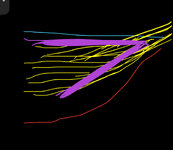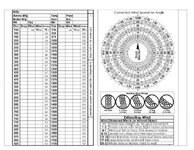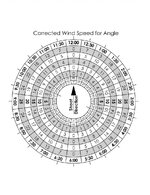WKR
WKR
- Joined
- Jun 14, 2019
- Messages
- 2,218
Yesterday while shooting a few mock nrl hunter stages we set up, me and a buddy were noticing that at the far targets our shots were trending high.
At first when the wind was sub 10 mph right to left we both had to adjust 0.2 down, later in the day when the wind picked up it was as much as .4-.5
Now, both of our rifles/loads have been trued and there was no doubt in either of our systems inputs or zeros, so we make sure pressure/ DA was true with a kestrel and again it was correct.
The only other explanation is the terrain. The far targets were across a steep canyon that had a significant vertical updraft.
We both have shot across canyons many times, but in this terrain it had the most notable effect. It's a long valley, and this canyon ridge is the first wind break coming up from the valley floor. So I'm thinking that without any other features to create turbulence or slow the wind down, that updraft is pushing the bullet travel upwards significantly.
Sub 650 yards, the effects were marginal, but once we got out to 800 and beyond it was substantial.
Anyone else experience this updraft on bullet flight when shooting over steep canyons? I'm used to horizontal winds doing weird things over canyons and in mountainous terrain, but the vertical aspect had never been as pronounced as it was for us yesterday.
It was good though, I like learning these things while practicing and training, as it really makes me think about my limits on game depending on environmentals
At first when the wind was sub 10 mph right to left we both had to adjust 0.2 down, later in the day when the wind picked up it was as much as .4-.5
Now, both of our rifles/loads have been trued and there was no doubt in either of our systems inputs or zeros, so we make sure pressure/ DA was true with a kestrel and again it was correct.
The only other explanation is the terrain. The far targets were across a steep canyon that had a significant vertical updraft.
We both have shot across canyons many times, but in this terrain it had the most notable effect. It's a long valley, and this canyon ridge is the first wind break coming up from the valley floor. So I'm thinking that without any other features to create turbulence or slow the wind down, that updraft is pushing the bullet travel upwards significantly.
Sub 650 yards, the effects were marginal, but once we got out to 800 and beyond it was substantial.
Anyone else experience this updraft on bullet flight when shooting over steep canyons? I'm used to horizontal winds doing weird things over canyons and in mountainous terrain, but the vertical aspect had never been as pronounced as it was for us yesterday.
It was good though, I like learning these things while practicing and training, as it really makes me think about my limits on game depending on environmentals



